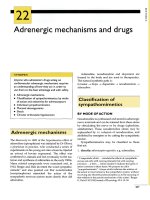24 hypertrophy training periodization
Bạn đang xem bản rút gọn của tài liệu. Xem và tải ngay bản đầy đủ của tài liệu tại đây (417.46 KB, 9 trang )
UNIVERSITY
Hypertrophy
Training
Periodization: The
big picture plan
The Lesson
What is periodization
Periodization models
Yearly training plan (macrocycle)
Post Show Programming
Offseason Programming
Precontest Programming
What is Periodization?
Planned manipulation of training variables to maximize adaptations (Buford 2007)
What are our main training variables to manipulate?
• Volume
• Intensity (relative and absolute)
• Frequency
What else might limit maximal adaptation?
Recovery capacity
Injuries
Adherence/Sustainability
*these are factored into manipulating variables as well to maximize adaptation, its not just
stimulus.
Different models of manipulating these variables have been proposed
•
•
•
•
Linear: volume decreases as intensity increases over time
Reverse Linear: intensity decreases as volume increases over time
Block: sections of time with focus on low load high volume and then high load low volume
Undulating: weekly rotation of volume and intensity focus
Which model is best?
These models do not have to exist alone, in practical application we
use a combination of all of them.
Regarding hypertrophy no model has been shown superior over
another model when volume is equated.
So the “best” plan is going to be one that allows you to handle an
optimal training volume and allow recovery to take place.
Within programming variables we will use ALL of these models across
the training year.
Periodization Models Applied
Linear: We will increase load and reps over time within hypertrophy
rep targets and volume is auto regulated based on recovery.
Undulating: We will manipulate rep ranges across training days based
on movement patterns, preparedness, and joint/tissue integrity.
Block: We have sections of time with higher recovery capacity and in
turn higher training volume, times with lower recovery and lower
volume needed.
Review the Hypertrophy Progression Lecture, we already know how to
do this!
The Yearly Plan (Macrocycle)
So we already now how to program and change variables based on
recovery in the short term. Long term how might this look?
Planning out the calendar year benefits:
Physique Goal timeline
Show timeline
PED usage and time off
Planned vacations/active rests
These different aspects are going to determine the programming
needs for the year
YEARLY PLAN MACRO CYCLE
POST SHOW BLOCK
2 months
OFFSEASON BLOCK 5-12 months
PRECONTEST BLOCK 4-6 months
CRUISE DOSAGE
OFFSEASON BLAST
PRECONTEST BLAST
OFFSEASON CRUISE
a cti ve i ntro 6 week del oad 6 week del oad 6 week del oad 6 week del oad/active 8 week del oad/tape 8 week
pea k
res t week vol ume
vol ume
vol ume
vol ume
res t
vol ume
r
vol ume week/deload
bl ock
bl ock
bl ock
bl ock
bl ock
bl ock
Post Show
Lowest training tolerance
Mental, physical (metabolic, hormonal, structural) recovery are focus
Intro week for new training plan and movements at ½ volume
6-week training phase autoregulated on recovery
Deload concludes phase
Offseason
Highest recovery capacity
Nutrition/PED usage drive up ability to recovery and progress stimulus
Blast vs Cruise training autoregulated volume/load/reps based on recovery
Blast vs Cruise training programming methods remain the same, volume adjusted via sets or
training frequency
Pre contest
Recovery capacity linearly decreases
Training volume will be tapered down to match recovery
Training frequency can increase to keep per session volume quality high
Deload can be implemented mid prep and peak week
Big Picture Programming
1. Set up your weekly training block (exercises, sets, reps, load, rest
periods)
2. Progress the load and reps over weeks and nail lift execution with
accuracy
3. Autoregulate exercises, set additions/subtractions, load/reps
selection based on recovery and performance
4. Deload reactively
Repeat this process in all phases of the year
References
Buford, T.W., et al., A comparison of periodization models during nine
weeks with equated volume and intensity for strength. J Strength Cond
Res, 2007. 21(4): p. 1245-50.
Grgic, J., et al. Should resistance training programs aimed at muscular
hypertrophy be periodized? A systematic review of periodized versus
non-periodized approaches. J Sci Sprts, 2018. 33(4). P. e97-e104.









